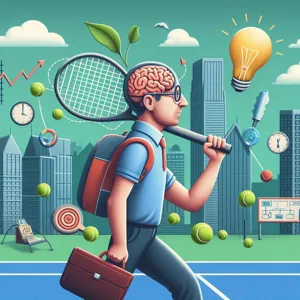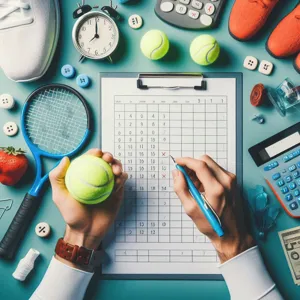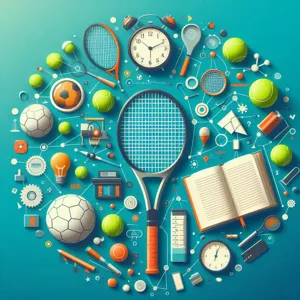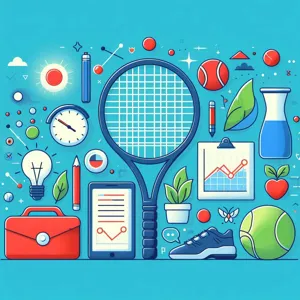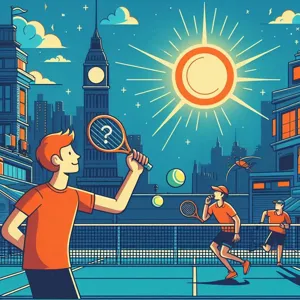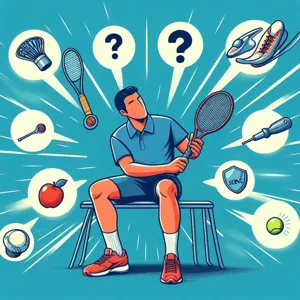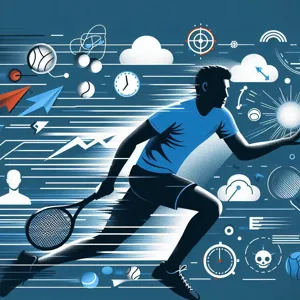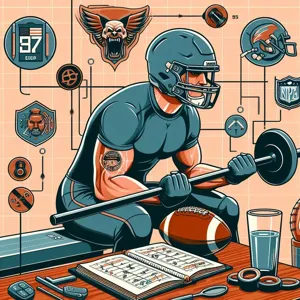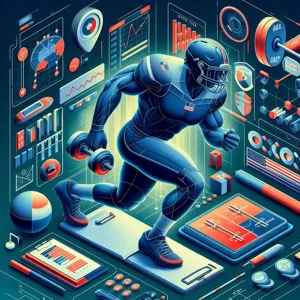Tennis is more than just a game; it’s a dynamic blend of skill, strategy, and mental fortitude that requires dedication and practice to master.
Whether you’re a budding enthusiast or a seasoned player looking to refine your technique, working with a coach can elevate your game to surprising new heights. However, to truly maximize your training sessions, it’s essential to approach each lesson with intention and focus. In this blog post, we’ll explore top tips for getting the most out of your time on the court with a coach, from setting clear goals and embracing feedback to cultivating a positive mindset and maintaining peak physical fitness. Join us as we delve into the best practices that will not only enhance your skills but also make your tennis journey more enjoyable and fulfilling. Get ready to serve up success and transform your training experience!
1. Understanding the Role of a Tennis Coach

Understanding the role of a tennis coach is crucial for any player looking to elevate their game. A tennis coach is not just a person who instructs you on how to hit forehands and backhands; they are your mentor, strategist, and motivator. They possess a wealth of knowledge that extends beyond the technical aspects of the game, encompassing mental fortitude, match strategies, and physical conditioning.
A good coach will assess your current skill level and tailor their teaching methods to suit your unique strengths and weaknesses. They will help you develop a personalized training regimen that aligns with your goals, whether that’s improving your serve, enhancing your footwork, or preparing for competitive matches. With their keen eye for detail, coaches can identify areas for improvement that you might overlook, providing constructive feedback that can lead to significant advancements in your performance.
Moreover, a tennis coach plays a pivotal role in fostering a positive mindset. They encourage resilience and focus, teaching you how to handle pressure during matches and stay motivated during practice sessions. By instilling a sense of discipline and commitment, they help you build the mental toughness required to excel on the court.
In essence, your relationship with your tennis coach should be a collaborative partnership. You bring the desire to learn and improve, while they provide the expertise and guidance necessary to reach new heights. Embrace this dynamic, and you’ll not only enhance your skills but also deepen your love for the game. Understanding the multifaceted role of your coach is the first step toward maximizing your training and achieving your tennis aspirations.
2. Setting Clear Goals for Your Training
Setting clear goals for your training is the cornerstone of maximizing your experience on the court with a coach. Without a defined target, your practice sessions can feel aimless and unproductive, leaving you frustrated rather than empowered. Start by reflecting on what you hope to achieve: Are you looking to improve your serve, enhance your footwork, or develop a more strategic approach to your matches?
Once you have a vision of your objectives, communicate them openly with your coach. This collaboration is essential. A good coach will help you refine these goals into specific, measurable, achievable, relevant, and time-bound (SMART) targets. For instance, instead of simply stating, “I want to get better at my backhand,” you might aim for “I want to consistently hit 70% of my backhands within the court during drills by the end of the month.”
Documenting your goals and regularly reviewing them provides a roadmap to track your progress. Celebrate small victories along the way—each practice session should bring you closer to your ultimate aim. Not only does this process foster motivation, but it also enhances your relationship with your coach, as they can tailor their strategies to help you achieve these milestones. With clear goals in place, your training sessions will transform from routine practices into focused, purposeful endeavors that lead you to become the player you aspire to be.
3. Importance of Open Communication with Your Coach

Open communication with your coach is the bedrock of a successful tennis training experience. It fosters a dynamic learning environment where both you and your coach can thrive. When you articulate your goals, concerns, and preferences, it allows your coach to tailor their coaching methods to suit your unique playing style and needs. This collaboration is key to maximizing your potential on the court.
Imagine stepping onto the court feeling uncertain about a particular stroke or strategy. If you keep those feelings bottled up, you might miss out on invaluable insights that could elevate your game. Instead, sharing your thoughts can lead to targeted drills and feedback that directly address your challenges. Whether it’s discussing your serve technique, footwork, or mental game, being transparent empowers your coach to provide the most relevant advice and support.
Moreover, open communication nurtures trust. A strong coach-player relationship built on mutual respect and understanding allows for constructive criticism without fear of discouragement. When you feel comfortable expressing your thoughts, you’re more likely to take risks and push your boundaries—essential components of growth in any sport.
Additionally, keep in mind that feedback should be a two-way street. Encourage your coach to share their observations about your performance, but also feel free to express what’s working for you and what isn’t. This dialogue can lead to some enlightening discussions that enhance your training sessions, making them not only productive but also enjoyable.
Ultimately, fostering open communication with your coach will create a more tailored and enriching training experience, ensuring that you get the most out of every session and continue to progress in your tennis journey. Remember, your coach is there to guide you, but they can only do so effectively if they know what you need. So, don’t hold back—speak up and watch your game soar to new heights!
4. Preparing Physically and Mentally for Training Sessions
Preparing both physically and mentally for your training sessions is crucial in maximizing your time on the court with your coach. Tennis is as much a mental game as it is a physical one; thus, a holistic approach to preparation can significantly enhance your performance.
**Physical Preparation:** Start by ensuring that your body is ready for the demands of a rigorous training session. This begins days in advance with a balanced diet rich in carbohydrates, proteins, and healthy fats to fuel your energy levels. Hydration is equally important—make it a habit to drink plenty of water in the days leading up to your session to keep your muscles hydrated and functioning optimally. On the day of training, engage in a dynamic warm-up routine that includes stretches and exercises tailored to tennis, such as lunges, arm circles, and lateral movements. This will not only increase your flexibility but also reduce the risk of injury, allowing you to perform at your best right from the outset.
**Mental Preparation:** Equally important is your mental state going into training. Before you step onto the court, take a moment to visualize your objectives for the session. Whether it’s improving your serve, perfecting a backhand, or simply working on your footwork, having a clear focus can help direct your efforts and maximize your learning. Additionally, incorporating mindfulness techniques such as deep breathing can help calm any pre-training jitters, allowing you to approach your session with a clear and positive mindset. Consider setting specific, achievable goals for each training session, and remind yourself to stay flexible and open-minded—learning takes time, and embracing the process is key to long-term improvement.
By prioritizing both your physical readiness and mental clarity, you’ll not only enhance your training experience with your coach but also pave the way for significant growth in your game. A well-prepared athlete is an unstoppable force on the court!
5. Effective Warm-Up Routines for Tennis

A well-structured warm-up routine is an essential component of any successful tennis training session. Not only does it prepare your body for the physical demands of the game, but it also helps to enhance your performance and reduce the risk of injury. Here are some effective warm-up strategies that you can incorporate into your training with a coach.
**Dynamic Stretching:** Start your warm-up with dynamic stretches to increase your heart rate and improve your range of motion. Focus on movements that engage the muscles you’ll be using on the court. Exercises like arm circles, leg swings, and torso twists will help loosen up your joints and get your blood flowing.
**Footwork Drills:** Tennis requires quick lateral movements, so incorporating footwork drills into your warm-up is crucial. Simple exercises like side shuffles or ladder drills can enhance your agility and prepare your legs for the rapid changes in direction that tennis demands. Your coach can guide you through these drills, ensuring you focus on proper technique and foot placement.
**Shadow Swinging:** Before picking up a racket, practice your strokes in the air. Shadow swinging allows you to focus on your form and technique without the pressure of hitting a ball. Visualize your shots and work on your footwork as you move through your swing patterns. This exercise will help you solidify your muscle memory and prepare your body for the real thing.
**Gradual Ball Hitting:** Once you’re warmed up, gradually introduce the ball into your routine. Start with soft, controlled hits with your coach from a short distance to get comfortable and build rhythm. As you progress, move back and increase the intensity of your shots. This gradual approach will help you acclimate to the game while ensuring you maintain proper form.
**Mental Preparation:** Don’t forget that warming up is also a mental exercise. Use this time to focus your mind on the session ahead, setting intentions and visualizing the challenges you want to tackle. Discuss your goals with your coach, as this can create a positive mindset and enhance your overall training experience.
Incorporating these effective warm-up routines into your training sessions will not only enhance your physical readiness but also boost your confidence and performance on the court. With the guidance of your coach, you’ll be well-prepared to maximize every moment of your training.
6. Key Drills to Focus On During Lessons
When it comes to maximizing your training sessions with a tennis coach, the drills you focus on during lessons can make all the difference in your development as a player. Selecting the right drills not only hones specific skills but also enhances your overall performance on the court. Here are some key drills that every player should prioritize during their coaching sessions.
**1. Groundstroke Consistency Drill**: This foundational drill is essential for developing reliable forehands and backhands. Your coach will feed balls to you from the baseline, and your goal is to rally back and forth, focusing on maintaining a consistent rhythm and placement. As your confidence grows, your coach may introduce variations, such as changing the speed or direction of the feeds, helping you adapt to different match situations.
**2. Serve and Return Practice**: Serving is one of the most critical aspects of tennis, setting the tone for each point. Spend time practicing your serve with your coach, focusing on grip, stance, and ball toss. After serving, switch roles and work on returning serves. This drill not only helps you improve your serve but also builds your ability to read and react to your opponent’s shots effectively.
**3. Volleys and Net Play**: Mastering the net game is vital for any aspiring player. Engage in volley drills where your coach feeds you balls at the net, requiring you to quickly adjust your positioning and technique. This session will sharpen your reflexes and teach you to control your shots under pressure, preparing you for crucial points during matches.
**4. Footwork Drills**: Tennis is as much about movement as it is about shot-making. Incorporate footwork drills, such as ladder drills or cone sprints, to enhance your agility and speed on the court. Paying special attention to your footwork during lessons will help you position yourself better for every shot, ultimately improving your performance.
**5. Match Simulation**: To bring everything together, include a match simulation drill in your lessons. Your coach will act as your opponent, allowing you to practice your strategies and shot selection in a game-like scenario. This is an excellent opportunity to implement the skills you’ve worked on and receive immediate feedback on your decision-making and execution.
By focusing on these key drills during your lessons, you’ll build a solid foundation of skills that will translate into improved performance on the court. Communicate openly with your coach about your goals, and let these targeted practices guide your training journey. As you refine your techniques and develop your game, you’ll find yourself not only more confident but also more prepared to tackle the challenges of competitive tennis.
7. Incorporating Feedback into Your Practice

Incorporating feedback into your practice is a cornerstone of effective tennis training, and it can significantly enhance your performance on the court. When you work with a coach, you gain access to a wealth of expertise and insights that can help you identify your strengths and areas for improvement. The key to maximizing this feedback lies in how you choose to integrate it into your sessions.
First and foremost, listen actively to your coach’s observations. Whether they point out a flaw in your serve or suggest a new strategy for approaching your opponent, taking the time to absorb this information is crucial. After your session, reflect on the feedback you received; consider keeping a training journal where you can jot down specific notes on what to focus on in your next practice. This not only reinforces your learning but also provides a tangible way to track your progress over time.
Next, set specific goals based on your coach’s feedback. For example, if your coach advises you to improve your footwork, create a targeted practice plan that includes drills specifically designed to enhance that skill. By defining clear objectives, you create a structured approach to your training, making it easier to monitor your improvements and maintain motivation.
During your practice, don’t hesitate to ask for clarification or further guidance as you work on incorporating feedback. Engaging in an open dialogue with your coach can lead to deeper understanding and more effective adjustments. You might also consider recording your practice sessions—videos can be invaluable for visual learners and allow you to see firsthand how well you’re implementing your coach’s advice.
Lastly, be patient with yourself as you incorporate feedback. Change takes time, and it’s natural to encounter challenges along the way. Embrace the process and celebrate small victories, as each step forward brings you closer to becoming the player you aspire to be. By actively integrating your coach’s insights into your practice, you’ll not only enhance your skills but also foster a more productive and rewarding training experience.
8. Developing a Balanced Training Schedule
Creating a balanced training schedule is essential for any tennis player looking to maximize their potential on the court. A well-structured routine not only helps you to improve your skills but also ensures that you maintain your physical and mental health throughout your training journey.
To begin with, consider incorporating a mix of technical drills, physical conditioning, match play, and recovery into your schedule. Technical drills should focus on enhancing your strokes, footwork, and overall technique, allowing you to refine your skills in a controlled environment. Pair these with physical conditioning sessions that emphasize strength, agility, and endurance—key components that will enhance your performance during matches.
It’s also vital to allocate time for match play, where you can apply what you’ve learned in a competitive setting. This not only boosts your ability to handle pressure but also gives you a sense of how to strategize against different opponents. However, don’t forget the importance of rest and recovery! Including recovery days in your schedule—whether through light practice, stretching, or even cross-training activities—will help prevent burnout and reduce the risk of injury.
Communication with your coach is crucial when developing your training schedule. They can provide valuable insights into your progress and suggest necessary adjustments based on your performance. Together, you can create a well-rounded routine that not only challenges you but also keeps you engaged and motivated.
Remember, a balanced training schedule is not just about the quantity of practice but the quality and diversity of your sessions. By thoughtfully planning your training, you’ll not only enhance your skills but also cultivate a deeper love for the game of tennis.
9. The Role of Nutrition in Tennis Performance
Nutrition plays a crucial role in maximizing your tennis performance, acting as the foundation upon which your training and gameplay are built. For players at any level, what you fuel your body with can significantly influence your energy levels, mental clarity, and overall physical endurance on the court.
Imagine stepping onto the court feeling sluggish and unfocused. That could be a result of poor dietary choices made in the days leading up to your match. To avoid this pitfall, it’s essential to adopt a balanced diet rich in carbohydrates, proteins, and healthy fats. Carbohydrates are your primary source of energy, so incorporating whole grains, fruits, and vegetables into your meals is vital. These foods provide the necessary glycogen stores that will power you through those long rallies and grueling matches.
In addition to your pre-match meals, hydration is another critical component of nutrition that should never be overlooked. Tennis matches can last for hours, and maintaining optimal hydration levels is key to sustaining your performance. Drink water regularly throughout the day, and consider electrolyte-rich sports drinks during prolonged play to replenish lost minerals.
Don’t forget about post-match nutrition either. After an intense session, your body needs to recover, and consuming a mix of protein and carbohydrates can help repair muscle tissue and replenish your energy stores. A simple smoothie with protein powder, banana, and spinach can do wonders for your recovery.
Lastly, consult with your coach or a nutritionist to tailor a nutrition plan specific to your training regimen and individual needs. By understanding the vital role that nutrition plays in your tennis performance, you can enhance your training, improve your stamina, and ultimately elevate your game on the court. Embrace nutrition as an integral part of your tennis journey, and watch as your performance reaches new heights.
10. Mental Strategies for On-Court Success
Mental strategies play a pivotal role in achieving success on the tennis court, often differentiating the good players from the great ones. As you work with your coach to improve your physical skills, it’s equally important to cultivate a strong mental game. Here are some effective strategies to enhance your mental toughness and focus.
First and foremost, visualization is a powerful tool. Before stepping on the court, take a few moments to close your eyes and envision yourself executing your shots flawlessly, moving gracefully, and winning points. This mental rehearsal not only prepares you for the physical demands of a match but also instills confidence, helping you to approach your practice sessions and matches with a winning mindset.
Equally important is the practice of positive self-talk. The inner dialogue you maintain can significantly influence your performance. Replace negative thoughts with affirmations and constructive phrases. Instead of thinking, “I can’t make this shot,” try telling yourself, “I am capable, and I will give it my best shot.” This shift in mindset can help you maintain focus and composure, especially during high-pressure moments.
Additionally, mastering your breathing techniques can greatly enhance your on-court performance. When you find yourself feeling anxious or overwhelmed, take a moment to pause and focus on your breath. Inhale deeply through your nose, hold for a few seconds, and exhale slowly through your mouth. This simple practice helps to calm your nerves, clear your mind, and regain your composure, allowing you to refocus on the task at hand.
Furthermore, set clear, achievable goals for each training session. Working with your coach, outline specific objectives that you want to accomplish, whether it’s improving your serve, mastering a new volley technique, or enhancing your footwork. Having tangible goals not only keeps you motivated but also provides a sense of purpose during your training, ensuring that you stay engaged and dedicated.
Lastly, don’t underestimate the power of mindfulness. Being present in the moment allows you to fully absorb the experience, whether it’s the rush of hitting a perfect forehand or the satisfaction of executing a successful strategy. Practicing mindfulness can help you remain focused, reducing distractions and enhancing your overall performance.
By incorporating these mental strategies into your training regimen, you will not only maximize your potential on the court but also develop the resilience and confidence needed to thrive in competitive matches. Your mind is just as important as your physical abilities, so nurture it with the same dedication you give to your tennis skills.
11. Tracking Your Progress and Improvements
Tracking your progress and improvements is a crucial component of maximizing your training with a tennis coach. Just as athletes meticulously analyze their gameplay, developing a systematic approach to monitor your advancements can significantly enhance your performance on the court.
Start by setting specific, measurable goals—these could range from improving your serve speed to reducing unforced errors during matches. Regularly document your practice sessions and matches to create a comprehensive record of your development. This can be done in a journal, or with the help of mobile apps specifically designed for athletes. Note down key metrics such as your win/loss ratio, shot accuracy, and even your mental state during matches.
Additionally, consider scheduling periodic assessments with your coach to evaluate your progress. This can involve structured drills that target particular skills, followed by feedback sessions where you can discuss what’s working well and what needs further focus. Embrace video analysis as well; recording your practice sessions allows you to visually dissect your technique, providing insights that may be missed in real-time.
Most importantly, celebrate your improvements, no matter how small. Whether you’ve achieved a new personal best in serve speed or consistently returned difficult shots with greater ease, acknowledging these milestones will keep you motivated and engaged in your training. By actively tracking your progress, you not only gain a clearer picture of your development but also foster a deeper connection with your coach, creating a collaborative environment focused on continuous improvement.
12. Building a Strong Coach-Athlete Relationship
building a strong coach-athlete relationship is fundamental to maximizing your training and excelling in tennis. This partnership goes beyond mere instruction; it’s about fostering trust, understanding, and open communication. When you establish a solid rapport with your coach, you create an environment where feedback is not only welcomed but actively sought. This encourages both parties to share insights, discuss strategies, and troubleshoot challenges together.
To cultivate this relationship, start by being open and honest about your goals and aspirations. Share your strengths and weaknesses, as well as any concerns you may have. This transparency allows your coach to tailor their approach to meet your unique needs, ensuring that your training sessions are as effective as possible. Remember, your coach is there not just to instruct but to support you on your journey to improvement.
Additionally, be receptive to feedback and willing to adapt your training based on your coach’s guidance. A strong relationship thrives on mutual respect, so showing appreciation for their expertise can go a long way. Engage in conversations about your progress, celebrate your achievements, and address difficulties together. This collaborative spirit will not only enhance your skills on the court but also foster a sense of camaraderie that makes practice enjoyable.
Finally, don’t underestimate the power of consistency. Regularly attending training sessions and being present during discussions reinforces that you value your coach’s time and commitment. By investing in this partnership, you’ll not only improve your tennis skills but also create a supportive atmosphere that encourages growth and resilience. A strong coach-athlete relationship is the backbone of any successful training regimen, laying the foundation for lasting success on and off the court.
13. When to Seek Additional Coaching Resources
Recognizing when to seek additional coaching resources can be a game-changer in your tennis journey. While having a dedicated coach is invaluable, there are times when supplementing your training with external resources can accelerate your progress and deepen your understanding of the game.
Consider exploring additional coaching resources when you notice a plateau in your performance. If you find yourself struggling to improve your skills despite regular practice, it may be time to seek out specialized instruction or workshops that focus on specific areas such as serving techniques, footwork, or match strategy. These resources can offer fresh perspectives and expert insights that help you break through barriers.
Another opportunity for additional coaching arises when you’re preparing for a tournament or significant match. Engaging with a coach who has experience in competitive play can provide tailored strategies and mental preparation techniques that are crucial for success in high-pressure situations. This is also the perfect time to incorporate video analysis, which allows you to visually dissect your game, identify weaknesses, and track your improvements over time.
Furthermore, consider online platforms or instructional videos that can complement your in-person coaching sessions. Many talented coaches and players share their skills and drills through digital mediums, making it easier than ever to access high-quality training content. Whether it’s refining your backhand, learning new drills, or studying the techniques of top players, these resources can be incredibly beneficial.
Lastly, don’t underestimate the power of peer learning. Joining group clinics or tennis clubs can foster a sense of community and provide opportunities to learn from fellow players. Observing others, participating in practice matches, and engaging in discussions about techniques can broaden your perspective and enhance your skills.
In summary, seeking additional coaching resources at the right times can supercharge your tennis training. By remaining proactive and open to new methods of learning, you’ll not only enhance your performance but also deepen your love for the game.
14. Balancing Practice with Match Play
Balancing practice with match play is crucial for a well-rounded tennis training regimen. While practice sessions allow for skill refinement, drill repetition, and focused improvement on specific techniques, match play provides the invaluable experience of applying those skills under pressure. As a player, it’s essential to strike the right equilibrium between these two components to enhance your overall performance.
When you step onto the practice court, it’s your time to dissect your strokes, work on your footwork, and fine-tune your serve. These sessions with your coach are designed to isolate certain aspects of your game, allowing you to experiment without the pressure of competition. However, the real test comes during match play, where the stakes are higher, and the dynamics change. Here, you must learn to adapt your strategy, manage your emotions, and respond to the unpredictability of an opponent’s game.
To effectively balance the two, consider scheduling structured practice sessions that focus on technical skills during the week, followed by intentional match play on weekends. This rhythm not only reinforces what you’ve practiced but also helps you to apply those techniques in real-game scenarios. Engaging in practice matches with your coach or fellow players can also simulate match conditions, allowing you to integrate your training into competitive situations.
Additionally, keep an open line of communication with your coach about your progress. After each match, discuss what worked well and what needs improvement. This feedback loop ensures that your practice sessions remain targeted and productive, addressing any weaknesses identified during competition.
Ultimately, the goal is to create a feedback cycle where practice informs match play, and match play reveals areas for further development. By maintaining this balance, you’ll be well-equipped to maximize your training and elevate your tennis performance to new heights.
15. Celebrating Milestones and Achievements in Your Training Journey
Celebrating milestones and achievements in your training journey is essential for maintaining motivation and fostering a positive mindset. Tennis is not just about perfecting your serve or mastering your backhand; it’s also about recognizing the small victories that build your overall confidence and skill. As you progress with your coach, take the time to acknowledge each achievement—whether it’s finally executing that tricky topspin shot, improving your footwork, or even successfully completing a series of challenging drills.
Setting specific, measurable goals is a great way to track your progress, and each time you reach one, make it a point to celebrate. This could be as simple as treating yourself to a favorite snack after a particularly tough practice, or even planning a fun day out with friends to mark your progress in the sport. You might also consider keeping a training journal where you document your achievements, however big or small, along with your thoughts and feelings about your development. This not only provides a tangible record of your hard work but also serves as inspiration during tougher training sessions when you might feel disheartened.
Moreover, involve your coach in the celebration process. Share your milestones with them and invite their feedback on how far you’ve come. Coaches appreciate seeing their players grow, and this can strengthen your relationship, creating a more supportive and encouraging training environment. Whether it’s a personal best in practice or a successful match, recognizing your accomplishments reinforces your commitment to improvement and reminds you that every small step contributes to your overall journey in tennis. By celebrating these moments, you’ll create a more enjoyable and fulfilling training experience, keeping your passion for the game alive and well.
In conclusion, maximizing your training sessions with a coach can be the key to unlocking your full potential on the tennis court. By implementing the tips we’ve shared, from setting clear goals to actively engaging in feedback, you’ll not only enhance your skills but also foster a deeper understanding of the game. Remember, the journey to improvement is a collaborative effort between you and your coach, so embrace the process with enthusiasm and dedication. As you apply these strategies, you’ll find yourself not only playing better but enjoying the game even more. Now, lace up those tennis shoes, hit the court, and make every practice count! Happy training!



